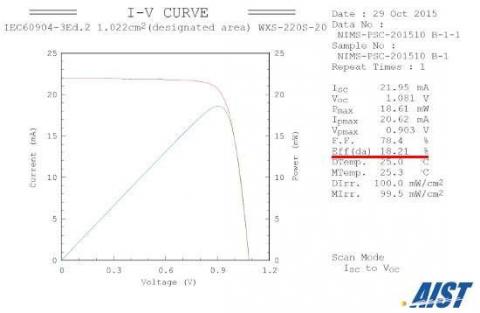A research group at the Japan-based National Institute for Materials Science (NIMS) reported the achievement of energy conversion efficiency exceeding 18% using standard size (1 cm2) perovskite solar cells. This measurement was made by the Calibration, Standards and Measurement Team at the Research Center for Photovoltaics, National Institute of Advanced Industrial Science and Technology (AIST)'an internationally recognized independent organization for solar cell evaluation.

The research group developed high-quality crystal particles that constitute a perovskite layer by adjusting the ratio of different cations in the layer and by substituting some of the iodine with bromine. Consequently, they were able to efficiently extract electrons and holes formed by exposure to light, and succeeded in increasing the short-circuit current density to more than 21 mA/cm2. Furthermore, they accurately controlled the thickness of layers in solar cells such as perovskite and electron transport layers and thereby reduced electrical resistance within the solar cells. As a result, they were able to reach this increased conversion efficiency of 18.2%.
In future studies, the research group plans to develop carrier transport materials with enhanced performance and perovskite materials capable of utilizing a wider range of solar wavelengths. They also aim to continue increasing the cell conversion efficiency to exceed the efficiency of polycrystalline silicon solar cells (approx. 20%) by controlling interfaces in perovskite solar cells.